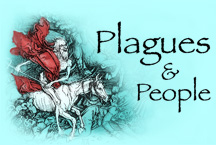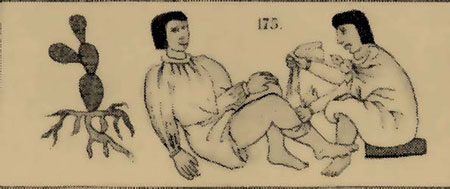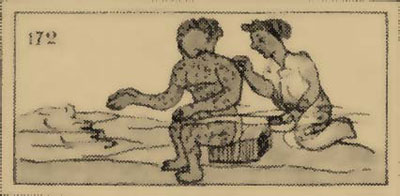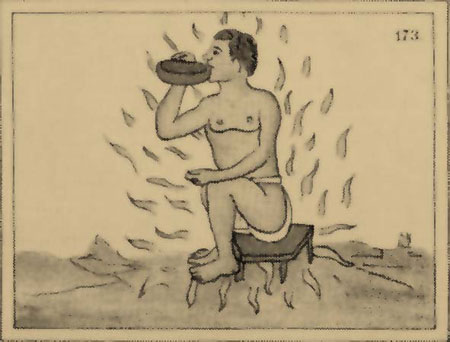Head Abscesses
Lime with piciyetl [pee-see-YAY-tl] is spread
on in quantity; with this they may abate. If this should fail, [the
abscess] is cut in the form of a cross; the pus comes out; it exudes.
Then it is washed with urine. A turpentine ointment is applied as
a poultice; later a poultice is made with pine resin.
piciyetl (described in Book XI): [Nicotiana
rustica; an herbaceous species of tobacco] Its leaves are wide,
somewhat long; and its blossoms are yellow. It is pounded with a
stone, ground, mixed with lime. He who suffers fatigue rubs himself
with it, likewise he who has the gout. And it is chewed. In
this manner is it chewed: it is only placed in the lips. It
intoxicates one, makes one dizzy, possesses one, and destroys hunger and
a desire to eat. He who has a swollen stomach places it on the stomach
and there in the navel.
Headache
Its cure is to inhale an herb named ecuxo [ay-KOO-shoh;
the "sneeze plant"], or to inhale [green] piciyetl.
The head is to be well covered, well wrapped, and the exposing to incense
[may follow]. And if it becomes worse, an herb named zozoyatic,
which is dried and pulverized, is to be inhaled. If [the ache] should
increase, [the pulverized herb] is applied in drops in the nose.
If it has worsened, if the nose [treatment] no longer helps, the use of
an obsidian point, of incising, of bleeding there [on the head] is necessary.
zozoyatic (described in Book XI): It is like a
little onion. At first this is dropped in the nose. Its roots,
leaves, seeds are all ground together. Only as a powder, or in solution,
a very little is dropped in the nose. If much of it is inhaled, if
much is dropped in the nose, it causes bleeding. It grows there at
Motlauhxauhcan, at the edge of the forest near Quauhnauac. It is
not potable.
Swelling of the face
Its cure is to eat a fried chameleon; then the ailment which is within
will go away. And all the purgatives are its cure, especially the
root named ololtic. And when this is drunk, [the ailment] is cast
out from the mouth and from below. And if the patient is of unsettled
stomach, he drinks an atole of raw, ground maize, or turkey broth.
Twice -- thrice -- yet purges the ailment. Thereafter he eats [a large
fried lizard, or a roast lizard. With this he will be cured.]
And to make [the patient] well, they proceed to make him drink water
[in which wood of the] so-called tlatlauhqui tree is boiled; and [they
use] its heart, not its bark.
[atole (ah-TOH-lee): A thick drink made with corn
meal soaked in water and strained through a sieve and then boiled until
it has the consistency of pap or porridge. Their are many kinds,
depending on the different flavors (fruit, honey, milk...) added to the
basic recipe.]
The Breaking of Bones
Treating a Broken Leg
In injuries, whether of the spine, or the ribs, or the leg, etc., [or]
whatsoever bone is injured, first that which is broken is pressed, stretched,
joined. Then zacacili root is cut; a very thick poultice [of
the pulverized root] is applied. Wooden splints are pressed on; they
are bound about it. And if there is a swelling around [the break],
it is pricked with an obsidian blade. Or [pulverized root of] iztac
zazalic is spread on; it is spread on with [pulverized] tememetlatl
root. Some bathe in it, some drink it in maguey wine, [some]
take a hot bath in it when there is itching. Or it is applied; [the
herb] named xipetziuh is applied. Some rub themselves with it, but
some drink it mixed with iztac zazalic; they also drink it in wine.
And if one is very sick, and his body is much fevered, and the bone is
exposed; a very resinous stick is cut; it is inserted within the bone,
bound within the incision, covered over with the medicine mentioned.
zacacili (described in Book XI): The leaves form
right next to the ground; they are long, broad, green like the leaves of
the Spanish omixochitl. They are not thick, only small and thin.
It has white flowers; its blossoms are useless. Its roots are a little
sweet. When one expels blood from his rectum, it is stopped with
this. They add chía or wrinkled chía to it. It
is drunk. An atole is made.
When one has eaten, then he drinks it. And he who breaks a foot
or a hand -- perhaps someone is struck, or someone is hurled to the ground -- or
there are slivers [in his foot], it is spread on there. Since it
is like pine resin or glue, when it is spread on where one is ailing, it
is as if someone pressed wooden slats on it. With it [pustules] are
broken, ripened; and when someone has some sliver embedded in the foot,
it draws it out.
It grows in the forest, especially there in the forests of Tecomic [and]
Xochimilco; however it grows everywhere.
iztac zazalic (described in Book XI): It is only a root.
Its leaves are green, small and round. It grows in this manner:
it only creeps. With it are cured those who pass blood or expel a
flux. And it is prepared thus: when roasted and mixed with
wrinkled chía, then it is ground. The sick one drinks it [in
an infusion].
tememetla (described in Book XI): Its leaves are wide,
thick. It is required by one who has a fever. It is ground
or only juiced when he drinks it; and he places it on his head. When
the eyes are inflamed, he applies some of it in drops to the eyes.
Thus the fever leaves.
[maguey: a cactus from which pulque and tequila
are made. Its leaves contain an excellent fiber, and its sap is fermented
to produce an intoxicating drink consumed before entering the sweathouse.
It is used as a base for other medicines. Pulque is a cloudy or whitish
fermented drink that was used medicinally for a variety of conditions -- coughing,
urinary problems, lice infestation -- as well as to ease childbirth and induce
lactation.]
A Constant Cough
One constantly coughs up mucus; then pus is expelled; [one goes on spitting
it out; then blood clots are expelled in quantity] from the nose.
Its remedy is [an infusion of] teouaxin with chili [and] salt; it is
to be cooked. One is to drink it many times. one constantly goes
on drinking it. And this teouaxin is [also] boiled; one goes on drinking
it with neither chili nor salt. Or one is to drink many times [an
infusion of] twigs named iztac chichicquauitl boiled in maguey wine.
One is not to eat immediately; one is to abstain from fruit; one is to
abstain from cold things; one is to drink -- one is to eat -- everything warm;
wine, maguey wine, white maguey wine also help. Only one drink [is
required].
And its remedy is [an infusion of the wood] named chichiualquauitl,
[which is] disagreeable to taste. It is not cooked; it is only warmed
in the sun, prepared in the morning. One is to drink this medicine
all day. And the next day one is still to drink [the water in which]
tlapalezquauitl is cooked. A little colored saltpeter is dropped
in.
Strangury [slow and painful urination]
For this will be drunk what is named "yellow urine medicine," the root
of [the herb] amaxtlatl, whether only in water, or in chocolate, or in
maguey wine with chili [and] gourd seeds, or in very little water.
Pustules
Treating Pustules
Their cure is the same [as for hemorrhoids]. One will proceed
to drink [an infusion of] tletlemaitl; one will take a hot bath in it.
One is to cover [the pustules] over with the powdered herb, tlalquequetzal,
or with copper filings.
And there are two kinds of pustules. The name of one kind [is]
"filthy pustules," and they gave [the other] the name "silk-cotton tree
pustules" [or] "small pustules." They are very painful, very paralyzing.
They cause twisting of the hands [and] the feet, because the ailment penetrates
completely. And when they erupt, one drinks [an atole of] fish-amaranth
seeds. And one is to drink [an infusion of] quauhtlepatli; four times,
five times [a day] one is to drink it. One is to take a bath in it.
And if one's hands [and] one's feet become twisted, one is to drink a purgative,
the root [of an herb] named tlatlapanaltic, which is like caxtlatlapan.
And later one is bled with an obsidian blade.
And this same cure is for the "filthy pustules."
tlalquequetzal (described in Book XI): Its leaves,
its branches are ashen, spreading, serrated. It is a cough medicine;
it is a medicine for overeating.
caxtlatlapan (described in Book XI): Its foliage is cord-like;
its leaves are round. Some of its blossoms are white, some chili-red,
some blue. They are cylindrical at the base, whorl-shaped at the
top. Its tendrils are soft, tender, searching, delicate like greens.
Fever
Treating a Fever
One drinks [an infusion of the root of] chichipilli, [with] alum [and]
acid water. First one is purged; then [an infusion from] the edible
root of the sand tomato is drunk, adding to it the root of tacanalquilitl.
The grown people drink [an infusion of] two sand tomato roots; small children
drink [an infusion of] four. And five kernels of maize are mixed
in this. And when there is fever, one is to drink [an infusion of
the root of] aitztoli in acid water.
tacanalquilitl (described in Book XI): Its leaves
are tacanlli. Its habitat is in the mountains. It is ash-colored,
faded to an ash color. It can be cooked in an olla, it can be baked
on a griddle.
aitztolin (described in Book XI): It grows by the water,
on the water's edge. Its green leaves are many, solid, like the reeds
of Castile. Its leaves have a sharp edge; they are hard. Its
blossom forms a stalk; it is tawny, small, straight and long. Two,
three cluster together. It is edible.
And if I shall feel much hunger, I shall relieve it with this when I
have nothing to eat. Also [with the blossoms] tortilas can be made;
they can be cooked on a griddle.
Its root is small and round, black on its surface, white on its inside.
And when it is ground, it is peeled; it becomes red. This is a little
sweet. It is required by one whose urine is completely stopped, when
he can no longer urinate [and] his stomach really distends. He drinks
it during fasting, whenever he desires. Thereby [the urine] drops
out; it removes the sand or whatever is clotted within the bladder.
It grows everywhere in the sweet water. |




